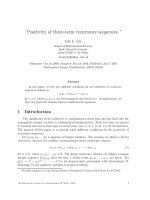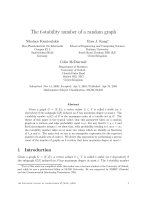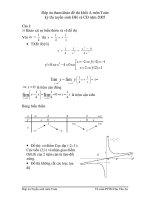Toán 1
Bạn đang xem bản rút gọn của tài liệu. Xem và tải ngay bản đầy đủ của tài liệu tại đây (258.04 KB, 29 trang )
The t-stability number of a random graph
Nikolaos Fountoulakis
Max-Planck-Institut f¨ur Informatik
Campus E1 4
Saarbr¨ucken 66123
Germany
Ross J. Kang
∗
School of Engineering and Computing Sciences
Durham University
South Road, Durham DH1 3LE
United Kingdom
Colin McDiarmid
Department of Statistics
University of Oxford
1 South Parks Road
Oxford OX1 3TG
United Kingdom
Submitted: Nov 14, 2009; Accepted: Apr 2, 2010; Published: Apr 19, 2010
Mathematics Subject Classification: 05C80, 05A16
Abstract
Given a graph G = (V, E), a vertex subset S ⊆ V is called t-stable (or t-
dependent) if the subgraph G[S] induced on S has maximum degree at most t. The
t-stability number α
t
(G) of G is the maximum order of a t-stable set in G. The
theme of this paper is the typical values that this parameter takes on a random
graph on n vertices and edge probability equal to p. For any fixed 0 < p < 1 and
fixed non-negative integer t, we show that, with probability tending to 1 as n → ∞,
the t-stability number takes on at most two values which we identify as functions
of t, p and n. The main tool we use is an asymptotic expression for the expected
number of t-stable sets of order k. We derive this expression by performing a precise
count of the number of graphs on k vertices that have maximum degree at most t.
1 Introduction
Given a graph G = (V, E), a vertex subset S ⊆ V is called t-stable (or t-dependent) if
the subgraph G[S] induced on S has maximum degree at most t. The t-stability number
∗
Part of this work was completed while this author was a doctoral student at the University of Oxford;
part while he was a postdoctoral fellow at McGill University. He was supported by NSERC (Canada)
and the Commonwealth Scholarship Commission (UK).
the electronic journal of combinatorics 17 (2010), #R59 1
α
t
(G) of G is the maximum order of a t-stable set in G. The main topic of this paper is
to give a precise formula for the t-stability number of a dense random graph.
The notion of a t-stable set is a generalisation of the notion of a stable set. Recall that
a set of vertices S of a graph G is stable if no two of its vertices are adjacent. In other
words, the maximum degree of G[S] is 0, and therefore a stable set is a 0-stable set.
The study of the order of the largest t-stable set is motivated by the study of the
t-improper chromatic number of a graph. A t-improper colouring of a graph G is a vertex
colouring with the property that every colour class is a t-stable set, and the t-improper
chromatic number χ
t
(G) of G is the least number of colours necessary for a t-improper
colouring of G. Obviously, a 0-improper colouring is a proper colouring of a graph, and
the 0-improper chromatic number is the chromatic number of a graph.
The t-improper chromatic number is a parameter that was introduced and studied
independently by Andrews and Jacobson [1], Harary and Fraughnaugh (n´ee Jones) [11, 12],
and by Cowen et al. [7]. The importance of the t-stability number in relation to the t-
improper chromatic number comes from the following obvious inequality: if G is a graph
that has n vertices, then
χ
t
(G)
n
α
t
(G)
.
The t-improper chromatic number also arises in a specific type of radio-frequency as-
signment problem. Let us assume that the vertices of a given graph represent transmitters
and an edge between two vertices indicates that the corresponding transmitters interfere.
Each interference creates some amount of noise which we denote by N. Overall, a trans-
mitter can tolerate up to a specific amount of noise which we denote by T . The problem
now is to assign frequencies to the transmitters and, more specifically, to assign as few
frequencies as possible, so that we minimise the use of the electromagnetic spectrum.
Therefore, any given transmitter cannot be assigned the same frequency as more than
T/N nearby transmitters — that is, neighbours in the transmitter graph — as otherwise
the excessive interference would distort the transmission of the signal. In other words, the
vertices/transmitters that are assigned a certain frequency must form a T/N-stable set,
and the minimum number of frequencies we can assign is the T/N-improper chromatic
number.
Given a graph G = (V, E), we let S
t
= S
t
(G) be the collection of all subsets of V that
are t-stable. We shall determine the order of the largest member of S
t
in a random graph
G
n,p
. Recall that G
n,p
is a random graph on a set of n vertices, which we assume to be
V
n
:= {1, . . . , n}, and each pair of distinct vertices is present as an edge with probability
p independently of every other pair of vertices. Our interest is in dense random graphs,
which means that we take 0 < p < 1 to be a fixed constant.
We say that an event occurs asymptotically almost surely (a.a.s.) if it occurs with
probability that tends to 1 as n → ∞.
the electronic journal of combinatorics 17 (2010), #R59 2
1.1 Related background
The t-stability number of G
n,p
for the case t = 0 has been studied thoroughly for both fixed
p and p(n) = o(1). Matula [20, 21, 22] and, independently, Grimmett and McDiarmid [10]
were the first to notice and then prove asymptotic concentration of the stability number
using the first and second moment methods. For 0 < p < 1, define b := 1/(1 − p) and
α
0,p
(n) := 2 log
b
n − 2 log
b
log
b
n + 2 log
b
(e/2) + 1.
For fixed 0 < p < 1, it was shown that for any ε > 0 a.a.s.
⌊α
0,p
(n) − ε⌋ α
0
(G
n,p
) ⌊α
0,p
(n) + ε⌋, (1)
showing in particular that χ(G
n,p
) (1 − ε)n/α
0,p
(n). Assume now that p = p(n) is
bounded away from 1. Bollob´as and Erd˝os [4] extended (1) to hold with p(n) > n
−δ
for
any δ > 0. Much later, with the use of martingale techniques, Frieze [9] showed that for
any ε > 0 there exists some constant C
ε
such that if p(n) C
ε
/n then (1) holds a.a.s.
Efforts to determine the chromatic number of G
n,p
took place in parallel with the
study of the stability number. For fixed p, Grimmett and McDiarmid conjectured that
χ(G
n,p
) ∼ n/α
0,p
(n) a.a.s. This conjecture was a major open problem in random graph
theory for over a decade, until Bollob´as [2] and Matula and Kuˇcera [19] used martingales
to establish the conjecture. It was crucial for this work to obtain strong upper bounds on
the probability of nonexistence in G
n,p
of a stable set with just slightly fewer than α
0,p
(n)
vertices. Luczak [18] fully extended the result to hold for sparse random graphs; that is,
for the case p(n) = o(1) and p(n) C/n for some large enough constant C. Consult
Bollob´as [3] or Janson, Luczak and Ruci´nski [15] for a detailed survey of these as well as
related results.
For the case t 1, the first results on the t-stability number were developed indirectly
as a consequence of broader work on hereditary properties of random graphs. A graph
property — that is, an infinite class of graphs closed under isomorphism — is said to be
hereditary if every induced subgraph of every member of the class is also in the class. For
any given t, the class of graphs that are t-stable is an hereditary property. As a result
of study in this more general context, it was shown by Scheinerman [25] that, for fixed
p, there exist constants c
p,1
and c
p,2
such that c
p,1
ln n α
t
(G
n,p
) c
p,2
ln n a.a.s. This
was further improved by Bollob´as and Thomason [5] who characterised, for any fixed p,
an explicit constant c
p
such that (1 − ε)c
p
ln n α
t
(G
n,p
) (1 + ε)c
p
ln n a.a.s. For any
fixed hereditary property, not just t-stability, the constant c
p
depends upon the property
but essentially the same result holds. Recently, Kang and McDiarmid [16, 17] considered
t-stability separately, but also treated the situation in which t = t(n) varies (i.e. grows)
in the order of the random graph. They showed that, if t = o(ln n), then a.a.s.
(1 − ε)2 log
b
n α
t
(G
n,p
) (1 + ε)2 log
b
n (2)
(where b = 1/(1−p), as above). In particular, observe that the estimation (2) for α
t
(G
n,p
)
and the estimation (1) for α
0
(G
n,p
) agree in their first-order terms. This implies that as
long as t = o(ln n) the t-improper and the ordinary chromatic numbers of G
n,p
have
roughly the same asymptotic value a.a.s.
the electronic journal of combinatorics 17 (2010), #R59 3
1.2 The results of the present work
In this paper, we restrict our attention to the case in which the edge probability p and
the non-negative integer parameter t are fixed constants. Restricted to this setting, our
main theorem is an extension of (1) and a strengthening of (2).
Theorem 1 Fix 0 < p < 1 and t 0. Set b := 1/(1 − p) and
α
t,p
(n) := 2 log
b
n + (t − 2) log
b
log
b
n + log
b
(t
t
/t!
2
) + t log
b
(2bp/e) + 2 log
b
(e/2) + 1.
Then for every ε > 0 a.a.s.
⌊α
t,p
(n) − ε⌋ α
t
(G
n,p
) ⌊α
t,p
(n) + ε⌋.
We shall see that this theorem in fact holds if ε = ε(n) as long as ε ≫ ln ln n/
√
ln n.
We derive the upper bound with a first moment argument, which is presented in
Section 3. To apply the first moment method, we estimate the expected number of t-
stable sets that have order k. In particular, we show the following.
Theorem 2 Fix 0 < p < 1 and t 0. Let α
(k)
t
(G) denote the number of t-stable sets of
order k that are contained in a graph G. If k = O(ln n) and k → ∞ as n → ∞, then
E(α
(k)
t
(G
n,p
)) =
e
2
n
2
b
−k+1
k
t−2
tbp
e
t
1
t!
2
k/2
(1 + o(1))
k
.
(Note that by (2) the condition on k is not very restrictive.) Using this formula, we will
see in Section 3 that the expected number of t-stable sets with ⌊α
t,p
(n) + ε⌋ + 1 vertices
tends to zero as n → ∞.
The key to the calculation of this expected value is a precise formula for the number of
degree sequences on k vertices with a given number of edges and maximum degree at most
t. In Section 2, we obtain this formula by the inversion formula of generating functions
— applied in our case to the generating function of degree sequences on k vertices and
maximum degree at most t. This formula is an integral of a complex function that is
approximated with the use of an analytic technique called saddle-point approximation.
Our proof is inspired by the application of this method by Chv´atal [6] to a similar gen-
erating function. For further examples of the use of the saddle-point method, consult
Chapter VIII of Flajolet and Sedgewick [8].
The lower bound in Theorem 1 is derived with a second moment argument in Section 4.
We remark that Theorems 1 and 2 are both stated to hold for the case t = 0 (if we
assume that 0
0
= 1) in order to stress that these results generalise the previous results
of Matula [20, 21, 22] and Grimmett and McDiarmid [10]. Our methods apply for this
special case, however in our proofs our main concern will be to establish the results for
t 1.
the electronic journal of combinatorics 17 (2010), #R59 4
In Section 5 we give a quite precise formula for the t-improper chromatic number of
G
n,p
. For t = 0, that is, for the chromatic number, McDiarmid [23] gave a fairly tight
estimate on χ(G
n,p
)(= χ
0
(G
n,p
)) proving that for any fixed 0 < p < 1 a.a.s.
n
α
0,p
(n) − 1 − o(1)
χ
0
(G
n,p
)
n
α
0,p
(n) − 1 −
1
2
−
1
1−(1−p)
1/2
+ o(1)
.
Panagiotou and Steger [24] recently improved the lower bound showing that a.a.s.
χ
0
(G
n,p
)
n
α
0,p
(n) −
2
ln b
− 1 + o(1)
,
and asked if better upper or lower bounds could be developed. In Section 5, we improve
upon McDiarmid’s upper bound and we generalise (for t 1) both this new bound and
the lower bound of Panagiotou and Steger.
Theorem 3 Fix 0 < p < 1 and t 0. Then a.a.s.
n
α
t,p
(n) −
2
ln b
− 1 + o(1)
χ
t
(G
n,p
)
n
α
t,p
(n) −
2
ln b
− 2 − o(1)
.
Given a graph G, let the colouring rate α
0
(G) of G be |V (G)|/χ
0
(G), which is the
maximum average size of a colour class in a proper colouring of G. Then the case t = 0
of Theorem 3 implies for any fixed 0 < p < 1 that a.a.s.
α
0,p
(n) −
2
ln b
− 2 − o(1) α
0
(G
n,p
) α
0,p
(n) −
2
ln b
− 1 + o(1).
Thus the colouring rate of G
n,p
is a.a.s. contained in an explicit interval of length 1 + o(1).
We remark that Shamir and Spencer [27] showed a.a.s.
˜
O(
√
n)-concentration of χ
0
(G
n,p
)
— see also a recent improvement by Scott [26]. (The
˜
O notation ignores logarithmic
factors.) It therefore follows that α
0
(G
n,p
) is a.a.s.
˜
O(n
−1/2
)-concentrated.
The above discussion extends easily to t-improper colourings.
2 Counting degree sequences of maximum degree t
Given non-negative integers k, t with t < k, we let
C
2m
(t, k) :=
(d
1
,...,d
k
),
P
i
d
i
=2m,d
i
t
1
i
d
i
!
.
(Here, the d
i
are non-negative integers.) Given a fixed degree sequence (d
1
, . . . , d
k
) with
i
d
i
= 2m, the number of graphs on k vertices (v
1
, . . . , v
k
) where v
i
has degree d
i
is at
most
1
i
d
i
!
(2m)!
m!2
m
.
the electronic journal of combinatorics 17 (2010), #R59 5
See for example [3] in the proof of Theorem 2.16 or Section 9.1 in [15] for the defini-
tion of the configuration model, from which the above claim follows easily. Therefore,
C
2m
(t, k)(2m)!/(m!2
m
) is an upper bound on the number of graphs with k vertices and
medges such that each vertex has degree at most t. Note also that (2m)!C
2m
(t, k) is the
number of allocations of 2m balls into k bins with the property that no bin contains more
than t balls.
In the proof of Theorem 2, we need good estimates for C
2m
(t, k), when 2m is close
to tk. In particular, as we will see in the next section (Lemma 7) we will need a tight
estimate for C
2m
(t, k) when t− ln k/
√
k < 2m/k < t− 1/(
√
k ln k), since in this range the
expected number of t-stable sets having m edges is maximised. We require a careful and
specific treatment of this estimation due to the fact that 2m/k is not bounded below t.
For t 1, note that C
2m
(t, k) is the coefficient of z
2m
in the following generating
function:
G(z) = R
t
(z)
k
=
t
i=0
z
i
i!
k
.
Cauchy’s integral formula gives
C
2m
(t, k) =
1
2πi
C
R
t
(z)
k
z
2m+1
dz,
where the integration is taken over a closed contour containing the origin.
Before we state the main theorem of this section, we need the following lemma, which
follows from Note IV.46 in [8].
Lemma 4 Fix t 1. The function rR
′
t
(r)/R
t
(r) is strictly increasing in r for r > 0.
For each y ∈ (0, t), there exists a unique positive solution r
0
= r
0
(y) to the equation
rR
′
t
(r)/R
t
(r) = y and furthermore the function r
0
(y) is a continuous bijection between
(0, t) and (0,∞). Thus, if we set
s(y) = r
0
(y)
d
dx
xR
′
t
(x)
R
t
(x)
x=r
0
(y)
,
then s(y) > 0.
We will prove a “large powers” theorem to obtain a very tight estimate on C
2m
(t, k) when
2m/k is quite close to t. A version of this theorem holds if we instead assume that 2m/k
is bounded away from t; indeed, this immediately follows from Theorem VIII.8 of [8].
However, our version, where 2m/k approaches t, is necessary in light of Lemma 7 below.
Theorem 5 Assume that t 1 is fixed and k → ∞. Suppose that m and k are such
that t− ln k/
√
k 2m/k t − 1/(
√
k ln k) for any ε > 0, and r
0
and s are defined as in
Lemma 4. Then uniformly
C
2m
(t, k) =
1
2πks(2m/k)
R
t
(r
0
(2m/k))
k
r
0
(2m/k)
2m
(1 + o(1)).
the electronic journal of combinatorics 17 (2010), #R59 6
In the proof of the theorem (as well as in later sections), we make frequent use of the
following lemma, whose proof is postponed until the end of the section.
Lemma 6 If y = y(k) → t as k → ∞ (and y < t) and r
0
and s are defined as in
Lemma 4, then
r
0
=
t
t − y
+ O(1), (3)
dr
0
dy
=
r
0
2
t
1 + O
1
r
0
, and (4)
s =
t
r
0
1 + O
1
r
0
. (5)
Proof of Theorem 5 The proof is inspired by [6]. Throughout, we for convenience
drop the subscript and write R(z) in the place of R
t
(z). Recall that r
0
= r
0
(2m/k) is
the unique positive solution of the equation rR
′
(r)/R(r) = 2m/k, where t − ln k/
√
k
2m/k t − 1/(
√
k ln k), and let C be the circle of radius r
0
centred at the origin. Using
polar coordinates, we obtain
C
2m
(t, k) =
1
2πi
C
R(r
0
e
iϕ
)
k
r
0
2m+1
e
i2mϕ
e
iϕ
d(r
0
e
iϕ
) =
1
2πr
0
2m
π
−π
R(r
0
e
iϕ
)
k
e
i2mϕ
dϕ.
We let δ = δ(k) := ln k
r
0
/k and write
C
2m
(t, k) =
1
2πr
0
2m
2π−δ
δ
R(r
0
e
iϕ
)
k
e
i2mϕ
dϕ +
δ
−δ
R(r
0
e
iϕ
)
k
e
i2mϕ
dϕ
. (6)
Note that, since 2m/k < t − 1/(ln k
√
k), it follows from (3) that δ → 0 as k → ∞. We
shall analyse the two integrals of (6) separately.
To begin, we consider the first integral of (6) and we wish to show that it makes a
negligible contribution to the value of C
2m
(t, k). Note that
R(r
0
e
iϕ
)
2
=
t
j=0
r
0
j
j!
cos(jϕ)
2
+
t
j=0
r
0
j
j!
sin(jϕ)
2
=
0j
1
,j
2
t
r
0
j
1
+j
2
j
1
!j
2
!
(cos(j
1
ϕ) cos(j
2
ϕ) + sin(j
1
ϕ) sin(j
2
ϕ))
=
0j
1
,j
2
t
r
0
j
1
+j
2
j
1
!j
2
!
cos ((j
1
− j
2
)ϕ)
= R(r
0
)
2
−
0j
1
<j
2
t
2r
0
j
1
+j
2
j
1
!j
2
!
(1 − cos ((j
1
− j
2
)ϕ)) . (7)
Note that r
0
→ ∞ as k → ∞. Hence, from (7),
R(r
0
e
iϕ
)
2
R(r
0
)
2
1 −
2r
0
2t−1
t!(t−1)!
(1 − cos ϕ)
r
0
2t
t!
2
+ Θ(r
0
2t−1
)
= R(r
0
)
2
1 − (1 + o(1))
2t
r
0
(1 − cos ϕ)
.
the electronic journal of combinatorics 17 (2010), #R59 7
It follows that for k large enough
2π−δ
δ
R(r
0
e
iϕ
)
k
e
i2mϕ
dϕ
2πR(r
0
)
k
1 − (1 + o(1))
2t
r
0
(1 − cos δ)
k/2
2πR(r
0
)
k
exp
−
tk
2r
0
(1 − cos δ)
= 2πR(r
0
)
k
exp
−
t
2
·
kδ
2
r
0
ln k
·
1 − cos δ
δ
2
· ln k
. (8)
Since δ → 0, we have that (1 − cos δ)/δ
2
→ 1/2. By the choice of δ, we also have that
kδ
2
/(r
0
ln k) → ∞ as k → ∞, and it follows from Inequality (8) that
2π−δ
δ
R(r
0
e
iϕ
)
k
e
i2mϕ
dϕ
< R(r
0
)
k
/k, (9)
for large enough k.
In order to precisely estimate the second integral of (6), we consider the function
f : R → C given by
f(ϕ) := R(r
0
e
iϕ
) exp
−i
2m
k
ϕ
= exp
−i
2m
k
ϕ
t
j=0
r
0
j
j!
(cos(jϕ) + i sin(jϕ))
.
The importance of the function f is that
δ
−δ
R(r
0
e
iϕ
)
k
e
i2mϕ
dϕ =
δ
−δ
f(ϕ)
k
dϕ.
We will show that the real part of f(ϕ)
k
is well approximated by R(r
0
)
k
exp(−skϕ
2
/2)
when |ϕ| is small — see (12) below. The imaginary part can be ignored as the integral
approximates a real quantity.
To this end we will apply Taylor’s Theorem, and in order to do this we shall need the
first, second and third derivatives of f with respect to ϕ. First,
f
′
(ϕ) = exp
−i
2m
k
ϕ
t
j=0
r
0
j
j!
2m
k
− j
(sin(jϕ) − i cos(jϕ))
.
Note that
f
′
(0) = −i
2m
k
t
j=0
r
0
j
j!
−
t
j=0
r
0
j
j!
j
= −i
2m
k
R(r
0
) − r
0
R
′
(r
0
)
= 0
by the choice of r
0
. Next,
f
′′
(ϕ) = − i
2m
k
f
′
(ϕ) + exp
−i
2m
k
ϕ
t
j=0
r
0
j
j!
2m
k
− j
j(cos(jϕ) + i sin(jϕ))
.
the electronic journal of combinatorics 17 (2010), #R59 8
Therefore,
f
′′
(0) = −i
2m
k
f
′
(0) +
t
j=0
r
0
j
j!
2m
k
− j
j
=
2m
k
t
j=1
r
0
j
j!
j −
t
j=1
r
0
j
j!
j(j − 1) −
t
j=1
r
0
j
j!
j
=
r
0
R
′
(r
0
)
R(r
0
)
r
0
R
′
(r
0
) − r
0
2
R
′′
(r
0
) − r
0
R
′
(r
0
)
= −r
0
−r
0
R
′
(r
0
)
2
R(r
0
)
+ r
0
R
′′
(r
0
) + R
′
(r
0
)
= −R(r
0
)r
0
(r
0
R
′′
(r
0
) + R
′
(r
0
))R(r
0
) − r
0
R
′
(r
0
)
2
R(r
0
)
2
= −R(r
0
)r
0
d
dx
xR
′
(x)
R(x)
x=r
0
= −R(r
0
)s(2m/k). (10)
Thus, f
′′
(0) < 0 by Lemma 4. Last, we have
f
′′′
(ϕ) =− i
2m
k
f
′′
(ϕ) − i
2m
k
exp
−i
2m
k
ϕ
t
j=0
r
0
j
j!
2m
k
− j
j(cos(jϕ) + i sin(jϕ))
+ exp
−i
2m
k
ϕ
t
j=0
r
0
j
j!
2m
k
− j
j
2
(− sin(jϕ) + i cos(jϕ))
.
Since r
0
→ ∞ as k → ∞, there is a positive constant a such that a r
0
, for k
sufficiently large. Clearly, f(0) = R(r
0
) > a
t
/t! > 0. The continuity of f on the compact
set −π ϕ π implies that there is a positive constant δ
0
such that whenever |ϕ| δ
0
we have Re(f(ϕ)) > 0. Since the first two derivatives of Im(f(ϕ)) with respect to ϕ
vanish when ϕ = 0, and also Im(f(0)) = 0, Taylor’s Theorem implies that
|Im(f(ϕ))| sup
|ϕ|δ
0
|Im(f
′′′
(ϕ))|
ϕ
3
6
if |ϕ| δ
0
. Now, note that Re(f(ϕ)) and Im(f
′′′
(ϕ)) can be considered as polynomials
of degree t with respect to r
0
. The leading term of Re(f(ϕ)) is
Re
exp
−i
2m
k
ϕ
(cos(tϕ) + i sin(tϕ))
r
0
t
t!
;
thus, Re(f(ϕ)) = Ω(r
0
t
). On the other hand, using the derivative computations above
and simplifying, it follows that the leading term of Im(f
′′′
(ϕ)) is
Im
exp
−i
2m
k
ϕ
(sin(tϕ) + i cos(tϕ))
t −
2m
k
3
r
0
t
t!
.
the electronic journal of combinatorics 17 (2010), #R59 9
By (3), t−2m/k = (1 +o(1))t/r
0
and thus Im(f
′′′
(ϕ)) = O(r
0
t−1
). So, there exists c
1
> 0
such that for every ϕ with |ϕ| δ
0
sup
|ϕ|δ
0
|Im(f
′′′
(ϕ))|
|Re(f(ϕ))|
<
c
1
r
0
,
and therefore
Im(f(ϕ))
Re(f(ϕ))
c
1
ϕ
3
6r
0
,
for any ϕ with |ϕ| δ
0
. On the other hand, we have (see pages 15–16 of [6] for the
details)
Re(z
k
)
Re(z)
k
− 1
ǫ
k,
Im(z)
Re(z)
,
with
ǫ(k, x) = (1 + x)
k
− 1− xk e
xk
− 1
(for x 0). Since ǫ(k, x) increases in x for x 0, we have
1 − ǫ
k,
c
1
δ
3
6r
0
Re(f(ϕ)
k
)
Re(f(ϕ))
k
1 + ǫ
k,
c
1
δ
3
6r
0
, (11)
whenever |ϕ| δ δ
0
.
Next, we approximate the function ln Re(f(ϕ)). First,
d
dϕ
(ln Re(f(ϕ)))
ϕ=0
=
Re(f
′
(ϕ))
Re(f(ϕ))
ϕ=0
= 0.
Second, we have
d
2
dϕ
2
(ln Re(f(ϕ))) =
d
dϕ
Re(f
′
(ϕ))
Re(f(ϕ))
=
Re(f
′′
(ϕ))Re(f(ϕ))− Re(f
′
(ϕ))
2
Re(f(ϕ))
2
;
therefore, by Equation (10),
d
2
dϕ
2
(ln Re(f(ϕ)))
ϕ=0
=
Re(f
′′
(0))Re(f(0))− Re(f
′
(0))
2
Re(f(0))
2
=
−R(r
0
)s
R(r
0
)
= −s
Now, the numerator of the third derivative with respect to ϕ is
(Re(f
′′
(ϕ))Re(f(ϕ))− Re(f
′
(ϕ))
2
)
′
Re(f(ϕ))
2
− 2Re(f(ϕ))(Re(f
′′
(ϕ))Re(f(ϕ))− Re(f
′
(ϕ))
2
)
= Re(f (ϕ))
(Re(f
′′
(ϕ))Re(f(ϕ))− Re(f
′
(ϕ))
2
)
′
Re(f(ϕ))
− 2(Re(f
′′
(ϕ))Re(f(ϕ))− Re(f
′
(ϕ))
2
)
.
the electronic journal of combinatorics 17 (2010), #R59 10
Thus an elementary calculation gives that (for |ϕ| δ
0
)
d
3
dϕ
3
(ln Re(f(ϕ)))
=
Re(f
′′′
(ϕ))Re(f(ϕ))
2
− 3Re(f
′′
(ϕ))Re(f
′
(ϕ))Re(f(ϕ)) + 2Re(f
′
(ϕ))
3
Re(f(ϕ))
3
.
If, as we did earlier for Re(f (ϕ)) and Im(f
′′′
(ϕ)), we consider Re(f
′
(ϕ)), Re(f
′′
(ϕ)) and
Re(f
′′′
(ϕ)) as polynomials with respect to r
0
, we can show that Re(f
′
(ϕ)) = O(r
0
t−1
),
Re(f
′′
(ϕ)) = O(r
0
t−1
) and Re(f
′′′
(ϕ)) = O(r
0
t−1
). It then follows that there exists c
2
> 0
such that for every ϕ with |ϕ| δ
0
d
3
dϕ
3
(ln Re(f(ϕ)))
c
2
r
0
.
Therefore, Taylor’s Theorem implies that for every ϕ with |ϕ| δ
0
we have
ln Re(f(ϕ))−
ln R(r
0
) −
sϕ
2
2
c
2
ϕ
3
6r
0
.
It follows that
exp
−
c
2
kδ
3
6r
0
Re(f(ϕ))
k
R(r
0
)
k
exp(−skϕ
2
/2)
exp
c
2
kδ
3
6r
0
.
The condition that 2m/k < t − 1/(ln k
√
k) and (3) together imply that r
0
< t ln k
√
k +
O(1). Therefore, kδ
3
/r
0
=
r
0
/k ln
3
k → 0 as k → ∞, and we have
exp
c
2
kδ
3
6r
0
= 1 + o(1) and ǫ
k,
c
1
δ
3
6r
0
exp
c
1
kδ
3
6r
0
− 1 = o(1),
proving that
Re(f(ϕ)
k
) = R(r
0
)
k
exp(−skϕ
2
/2)(1 + o(1)) (12)
uniformly for |ϕ| δ. From (6), (9) and (12), we obtain
2πr
0
2m
C
2m
(t, k) = R(r
0
)
k
δ
−δ
exp(−skϕ
2
/2)dϕ + o(1)
. (13)
Using a change of variables ψ =
√
skϕ, observe that
δ
−δ
exp
−
skϕ
2
2
dϕ =
1
√
sk
δ
√
sk
−δ
√
sk
exp
−
ψ
2
2
dψ =
2π
sk
(1 + o(1)),
as k → ∞ since δ
√
sk ∼
√
t ln k → ∞. Thus, Equation (13) becomes
2πr
0
2m
C
2m
(t, k) =
2π
ks
R(r
0
)
k
(1 + o(1))
and the result follows.
the electronic journal of combinatorics 17 (2010), #R59 11









